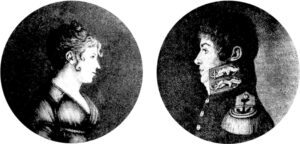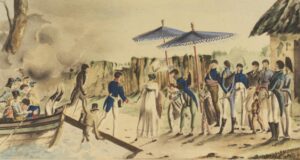A 200th anniversary
On the 10th of November 1820 the three-master Physicienne, formerly the American gun-runner Mercury but recently bought into the French Navy and now commanded by Louis de Freycinet, dropped anchor off Cherbourg, and the following day, as far as all those on board were concerned, she ended her journey in the harbour of Le Havre. Her brief naval career was almost over. She would soon be taken to Brest, and once there she would be sold off as a cargo vessel.
As the Physicienne approached France, de Freycinet must have been wondering whether his own naval career was also over. On the night before the corvette Uranie, his original command, left Toulon in September 1817 for a scientific circumnavigation of the globe, he had smuggled his wife Rose aboard and she had remained with the expedition through all its triumphs and, ultimately, disasters. Had he been returning in triumph in a Uranie loaded with specimens and samples and with log-books full of data after a successful voyage, he might have hoped that his blithe disregard of naval regulations would have been overlooked, but the Uranie was thousands of miles to the south, being pounded by waves and plundered by sealers on a beach in the Falkland islands. A captain who lost his ship, let alone a captain who had flouted naval regulations to the extent that he had done, could expect a court-martial at least. He cannot have forgotten that forty-five years earlier Yves-Joseph de Kerguelen had taken his mistress with him on his second voyage to the islands that now bear his name, and for that transgression had been summarily dismissed from the service on his return.

Rose and Louis de Freycinet. An illustration that may be a little misleading. The portrait of Rose is thought to have been painted just before her marriage, at the age of 17. The portrait of Louis, who as actually fifteen years her senior, was painted at least five years, and possibly as much as ten years, earlier.
On the other hand, Louis could have failed much more completely. He was at least returning in command of a ship that could be rated a corvette, even if much inferior to the Uranie, and with many of the scientific collections intact. And even though he had lost the Uranie, he had lost none of the officers and crew when he beached her, and he had ensured that everyone was adequately fed and sheltered, and had maintained discipline, throughout the ten long weeks marooned in Berkeley Sound (which he knew as the Baie de France). That had to stand to his credit, and he could even have been hoping that his achievements might be celebrated.
Neither his worst fears nor his best hopes were fulfilled, and what happened was extraordinary. The arrival of the Physicienne was virtually ignored. Mystified, Louis sent his First Lieutenant, Jérome-Frédéric Lamarche, to Paris to investigate, and two weeks later he received a letter of apology from one of the most important French scientists of his time, François Arago.
That Lamarche had sought out Arago is not surprising. He was a leading member of the Académie des Sciences that had sponsored the voyage and one of the greatest enthusiasts for it. He had, moreover, a very personal reason for wishing the expedition well. His younger brother Jacques was its official draughtsman and would, as it turned out, be the first person aboard to get an account of their adventures into print. For the inadequate reception in Le Havre, the elder Arago placed the blame entirely on the absence from Paris of Emmanuel Halgan, the responsible official at the Ministère de la Marine and on the ‘ineptitude’ of the subordinate he had left in charge. To sweeten the pill, he went on to compliment Louis on the importance of the results he had brought back and the breadth and depth of the collections made by the ship’s medical staff, who were also the expedition naturalists. He could not possibly have known at that early date whether this was or was not true, but he nonetheless added that he was sure that the acclaim Louis would undoubtedly receive from all the savants of Europe would compensate for ‘these initial small annoyances’. He ended his letter his letter by sending his sincere remembrances to ‘Madame de Freycinet’.

Rose de Freycinet centre-stage during the arrival of the Uranie at Dili, in Portuguese Timor (now Timor Leste). Unofficial depiction of the event by Jacques Arago. The picture that was circulated officially was the one drawn by Alphonse Pellion, one of the Uranie’s midshipmen and a talented artist who eventually became an admiral. It omits Rose, who was not supposed to be there.
After Arago’s letter, things did improve. Rose’s presence on board was not mentioned at the inevitable court-martial, which lasted a mere hour and a half, during which Louis was fully exonerated for the loss of his ship. His sword was returned to him with glowing compliments. The verdict was followed, on the 30th of December, by a personal audience with Louis XVIII, the ultimate sponsor of the expedition, who took the opportunity of informing him of his promotion. ‘You came here’, he was told, ‘a capitaine de frégate, you leave here a capitaine de vaisseau’. There is no account of what else was said, but the king was almost the only person in authority who did not find it politic to ignore the presence of Rose on the voyage, even though it had become common knowledge. He had, according to Benoit-Guyod (Au Temps de la Marine en Bois, Vol II, p34), been told about it very shortly after the Uranie had sailed, by no less a person than the minister for the Navy, but had merely commented ‘avec une souriante bonhomie’ that this act of marital devotion should be excused because it was unlikely to be imitated by anyone else .
It was in no-one’s interest to criticise Louis publicly or downplay his achievements, because one of the reasons for sending the Uranie out had been to re-establish the credibility of the French navy after more than a decade spent largely confined to port by British blockades. The voyage had to be presented as a success, and the Académie des Sciences proved itself equal to the task, convening a committee of some of the most distinguished scientists of the age, headed by François Arago, to write a preliminary report. The multiple objectives were discussed, and in each the achievements were applauded. The success of distillation of sea water in providing fresh water was noted, and its use on future voyages was recommended. It was also the committee’s opinion that even though the sort of detailed surveying so characteristic of the Baudin expedition had not been a priority, the voyage, staffed by ‘so many experienced and zealous officers’, would inevitably have made valuable additions to existing charts. It was all very upbeat, but it was very necessary that it should be.
Louis’ naval career was, nonetheless, effectively over, and he ended his days still a capitaine de vaisseau. Although he was in principle available for sea duty, he never commanded a naval vessel again. The ‘affair Rose‘ must have had much to do with this, but, as the leader of the expedition and as the man who had completed the reports on the Baudin expedition, it was obviously going to be his job to put together the reports, and most of those he wrote himself. It took him much of the rest of his life, and there were battles to be fought on the way. The Ministère de la Marine was disinclined to spend any money on publication, and some of the volumes appeared years after the official dates recorded on their title pages. The volumes on meteorology and terrestrial magnetism were not published until after Louis was dead, and his letters show a man becoming increasingly embittered as time passed and as interest waned in his story. And, he had lost the better part of himself when, in 1832, Rose succumbed to the cholera that had spared him. He died ten years later, at the château of a neighbour in Saulces sur Rhône.
And Rose? For a brief period her exploits were the talk of Paris, but she had no wish to exploit her fame, or notoriety. All she really wanted to do was to see again her mother, her friends and her husband’s female relatives, to whom she had become very close. And, also, she had a mission to accomplish. She had to deliver her handwritten journal, as promised, to her closest friend, Caroline de Nanteuil, and she did just that. In 1910 it found its way back to the Freycinet family but it might never have seen the light of day, because the Baron de Freycinet who received it considered some parts of it, innocuous as they now seem, too sensitive for general circulation. The heavily edited version that he did finally allowed to be published had, however, one outstanding merit. The editors replaced a missing part of the journal, covering most of the voyage through the Pacific, by Rose’s letters to her mother that covered the absent months. The surviving parts of the original journal and the letters as transcribed by Louis de Freycinet, almost certainly after Rose’s death, are now held by, and have been place on line by, the State Library of New South Wales, but there is still no full published version, in either French or English.
